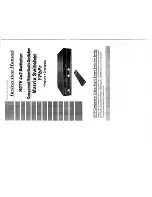
Waters Network Systems
User’s Manual
Page 85
GSM-2116 and GSM-2124
the authenticator to perform authentication message exchange or access the network from
the uncontrolled port.
Figure 5.53
Figure 5.53 represents a typical configuration; a single supplicant, an authenticator and an
authentication server. B and C are in the internal network, D is the Authentication server running
RADIUS, switch at the central location which acts as Authenticator connecting to PC A. A is a
PC outside the controlled port, running Supplicant PAE. In this case, PC A wants to access the
services on device B and C. It first must exchange the authentication message with the
authenticator on the port it connected via EAPOL packet. The authenticator transfers the
supplicant’s credentials to Authentication server for verification. If successful, the authentication
server will notify the authenticator. PC A is then allowed to access B and C via the switch. If
there are two switches directly connected together instead of a single one, the link ports
connecting the two switches may have to perform two port roles: authenticator and supplicant,
because the traffic is bi-directional.
Figure 5.54
Supplicant A
B
C
Authentication server
Authenticator
LAN
Authenticator
PAE
Services Offered
by Authenticator
(e.g Bridge Relay)
Authenticator’s System
Authentication
Server’s System
Authentication
Server
Supplicant
PAE
Uncontrolled port
Controlled port
MAC Enable
Port Authorize
Supplicant’s
System
Figure 3-53
















































